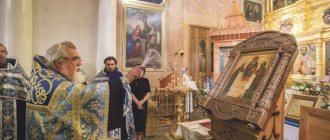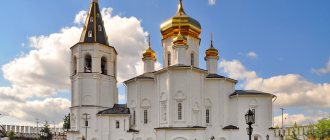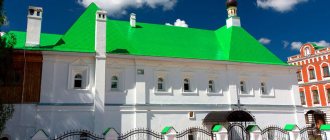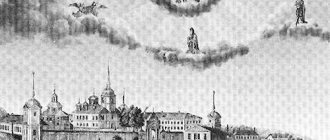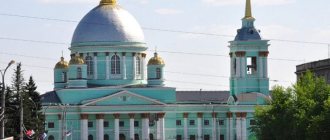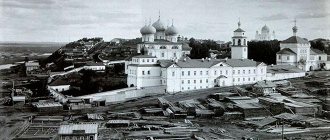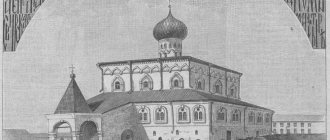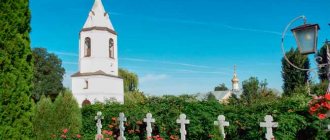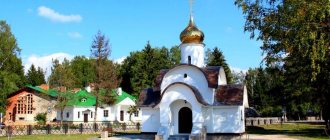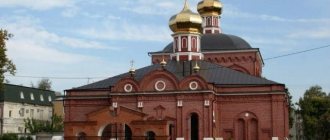Nilo-Stolobenskaya Hermitage is an Orthodox monastery on Seliger, in the Tver region. The monastery, home to about 50 monks, is located on Stolobny Island (entirely) connected by a bridge and on the Svetlitsa peninsula closest to it (partially).
The main shrine of the monastery is the relics of St. Neil of Stolobensky. The monastery was founded by Hieromonk Herman at the burial site of St. Nile on Stolobny Island in 1594.
Panoramic view of the monastery territory, © WelcomeTver
Excursions around the Nilo-Stolobenskaya desert
Tours of the monastery lasting 1–1.5 hours are available for guests. Attention is paid not only to the history of the monastery, but also to the modern life of the monastery. Donation for the excursion - 150 rubles.
In addition, those interested can visit the monastery museum, which has been operating since 2011. Entrance donation is 100 rubles, free for preschoolers. Excursion to the museum - 150 rubles.
Interior of the temple, © WelcomeTver
Legends
There is another legend about the saint. It says that the devil sent all sorts of misfortunes to the Nile. There were attacks by robbers, fires, Satan himself even tried to throw his cell into the lake. But Neil remained steadfast, overcoming all these attacks with faith and prayers.
He lived on the island for 27 years. Before his death, he left a will in which he asked to build a monastery on this site, which was done in the future. There is another belief according to which the Nile took a vow of non-lying, which is why he was never in a horizontal position. For example, he slept, hanging himself with ropes over his shoulders or on hooks that were driven into the wall.
Accommodation at the Nilo-Stolobenskaya Monastery
Pilgrims are accepted at 2 sites with simple but cozy rooms:
- Hotel of the Nilo-Stolbenskaya Hermitage Monastery. Accommodation at the hotel is comfortable - the rooms are spacious, each with a shower and toilet. The donation for accommodation ranges from 1000 rubles for a bed in a multi-bed room (from 4 to 7 beds in a room) to 3500 rubles for a triple room per day. The price of accommodation includes two meals a day. Applications for accommodation are accepted no earlier than 1 month before check-in.
- Pilgrim's house. The three-story pilgrim house is designed for 20–24 people. The rooms are equipped with ascetic wooden beds (in some rooms there are bunk beds), tables and chairs. There is also a kettle in each room. Bathroom and shower are on the floor. You can stay in the Pilgrim House for up to 3 days. You can book accommodation no earlier than 2 months in advance for groups of 5 people and no earlier than 1 month in advance for individual tourists. The donation for accommodation is 600 rubles, the price includes two meals a day. Priests and monks mainly stay in the Pilgrim House, so the appearance of the residents must correspond to the Orthodox tradition.
Territory of the Nilo-Stolobenskaya Hermitage Monastery, © WelcomeTver
When checking in, you must have an identification document.
Abbots, governors
- St. Herman Stolobensky (1594 - 1614)
- St. Nektary (Telyashin) (1614 - 1636)
- Dositheus (1636 - 1647) [1]
- Bogolep (1645 - 1647)
- St. Nektary (Telyashin) (1647 - 1667)
- Pachomius (? - 1667)
- Hermann (1667 - 1672)
- Alexander (20 January 1673 - 2 February 1679)
- Pachomius (1679 - 1695)
- Irinarch (1695 - 1713 (1714 and 15?)
- Dionysius (1714 - 1718)
- Paisiy (1719 - 1724)
- Hilarion (March 3, 1724 - 1734)
- Abraham (1734 - 1738; in 1735 - on trial in St. Petersburg)
- Varlaam (1739 - 1741)
- Dositheus (1741 - 1742)
- Pachomius (1743)
- Joasaph (1749)
- Vladimir (1751)
- Alexander (1754)
- Theodosius the Good (1755 - 1774)
- Feodosius (Buikov) (1774 - 1781)
- Ioannikiy (Burakovsky) (1781 - May 20, 1789)
- John (Terlikov) (June 1789 - June 17, 1797)
- Anastasy (1797 - 1798)
- Joasaph (Sretensky) (1798 - March 1, 1800)
- Nektary (Vereshchagin) (1800 - 1801)
- Pavel (1801 - 1839) [2]
- Agapit (Voinov) (1839 - 1849) [3]
- ….
- John (1851 - 1871) [3]
- Arseny (Nikolsky) (December 5, 1871 - February 14, 1897) [4]
- Pachomius (20 March 1897 [5] - +5 October 1908 [6])
- Leonid (December 2, 1908 [7] – March 3, 1911 [8])
- Nifont (April 25/May 11, 1911 - March 13/14, 1912) [9]
- Stefan (Danilov) (March 13/14 - April 3, 1912)
- Vasily (Biryukov) (April 3, 1912 - July 4, 1916)
- Apollinaris (July 26, 1916 [10] - ?)
- …
- Gabriel (Abalymov) (1919 - 1922) [3]
- Ioannikiy (Popov) (1922 - 1928)
- Vassian (Shusta) (1991 - 2010)
- Arkady (Gubanov) (May 31, 2010 - April 5, 2021)
- Ambrose (Ermakov) (August 25, 2022 - April 13, 2021) senior, Metropolitan. Tverskaya [11].
1928 - 1991 - closure
Schedule of services
Divine services are held daily in the Nilo-Stolobenskaya Hermitage. Daily services include:
- Memorial service - at noon on Sundays and holidays - litia.
- Prayer service with akathist to Nil Stolobensky - at 14:00.
- After the evening service - Procession of the Cross.
Services on weekdays:
- 05:30 - fraternal prayer service for Nil Stolobensky.
- 18:00-19:00 - evening service.
- 19:30 - Little Compline.
Services on Sundays and holidays:
- 8:00 - prayer service with akathist.
- 15:00 and 18:00 - liturgy.
- the night before from 20:00 to 9:00 - all-night vigil.
Schedule of services in the Nilo-Stolobenskaya Hermitage for the current month
Monastic life
Currently, about 50 inhabitants live in the monastery, less than half of whom are in the priesthood.
The monastery has several farmsteads, one of which is located in Torzhok. On its territory there are dairy, candle and carpentry shops, there is its own stable, cowshed, apiary, and in the church shop you can buy blessed honey.
This monastery even has its own jewelry workshop; great attention is paid to the revival of this craft. Novices of the monastery regularly take part in trade at Orthodox exhibitions and fairs. There is a hotel on its territory where arriving pilgrims can stay.
Shrines of the monastery of the Nilo-Stolobenskaya Hermitage
The most significant shrine of the monastery is the relics of Nil Stolobensky, the patron saint of the monastery and wonderworker. Other shrines of the temple: the icon of the Mother of God of Abalak, the icon of the Mother of God of Kazan, the honorable head of St. Nektarios, Archbishop of Tobolsk, Abbot of Stolobensky, a cross with particles of the holy relics of Spyridon of Trimifuntsky, an ark with particles of the holy relics of the venerable fathers of the Kiev-Pechersk.
© WelcomeTver
Before Soviet times, there were more holy icons in the monastery, but they were irretrievably lost. Among the missing shrines: the Vladimir Icon of the Mother of God; the first icon of Nil Stolobensky; ancient icon of Our Lady of Smolensk.
Virtual tour of the monastery
Through hardship to the stars
Since the place was a place of prayer, other hermit monks began to come here. In 1594, it was decided to found a monastery in honor of St. Neil. Planned and done. The monastery quickly became revered. Every year many pilgrims came to the island. In 1820, Emperor Alexander I himself came to Seliger for a visit. At the beginning of the 20th century, the number of monks in the monastery exceeded a thousand! The shores of the island were lined with stone. The monastery even had its own hospital.
Plan of the monastery at the beginning of the 19th century
The prosperity ended after the revolution, when the burial place of the Venerable Nil Stolobensky was opened and church valuables were looted. The further fate of the monastery was typical for that time - a penal colony, a concentration camp, a hospital, a nursing home, a camp site. The dilapidated complex was returned to the diocese only in the 90s. Soon the relics of St. Neil were transported to the monastery. Now there are 50 monks serving in the desert.
In total, there are six churches in the monastery. The main one is the Epiphany Cathedral, built in 1833. It rises in the very center of the monastery and stands out for its monumental classical architecture and five golden domes. The construction was supervised by the Italian architect Angelo Botani, so Tuscan motifs are clearly visible in the appearance of the building. This is where the relics of the saint are kept.
This is what the monastery looked like in 1789
The oldest is the Church of All Saints, built in 1701. It is small in size. When the Epiphany Cathedral was rebuilt, the temple served as a cathedral church. The relics of the founder of the monastery were temporarily transferred here. When a hospital building was added to it, the temple began to be called the hospital church. It is currently under restoration.
Next comes the temple of St. Neil of Stolobensky, which rises above the eastern gate. Hence its name - gateway. It was built in 1755. Money for construction was collected by all the people. When developing the project, we took the gate temple of the Donskoy Monastery in Moscow as a basis. It looks very elegant and light. The high rotunda is decorated with a golden ball and a cross, which are visible from afar.
The Church of the Holy Apostles Peter and Paul is equally beautiful. He appeared in the monastery in 1764. The temple is also a gateway and rises above the western gate of the monastery. The temple stood out for its rich interior decoration, including a carved wooden iconostasis, various sculptures and elegant stucco work.
The Church of the Exaltation of the Holy Cross is moved outside the monastery walls. In 1788, it was built on the very shore in the southwestern part of the island. The place was chosen for a reason. It was here that a chapel stood, erected in honor of the Monk Neil. Even Alexander I, during his visit to the monastery, was amazed at the elegant decoration of the church. The temple was decorated by masters from Ostashkov - icon painter Ilya Verzin and wood carver Kondraty Konyagin.
In 1820, Emperor Alexander I visited the monastery
But from the church of St. John the Baptist, only the foundation has survived. It is a pity, since it had special significance for believers, since it was located on the site where there was a dugout in which the Monk Neil originally lived. When they were digging a pit to build a church, they discovered the dugout itself. A depression was left in the floor of the temple in this place. During the Soviet period, the church was destroyed to the ground. Currently, the foundation has only been cleared.
The monastery has its own production - a candle factory, a cowshed, a dairy shop, an apiary and even a jewelry workshop. Ecological products are produced here. Stolobensky bread is very popular. It is baked without yeast using water from the holy Okovets spring. They also bake rye bread with malt, which they produce themselves. The assortment includes homemade cookies - honey, curd, almond, oatmeal. There are honey-chocolate gingerbreads.
Church shop
The shop also sells a variety of jams and canned salads – spicy and cucumber. The monastic assortment includes salted and smoked fish caught in Seliger, herbal teas, honey and dairy products from the farmstead - milk, butter, cottage cheese. All products are very fresh and tasty. As spiritual food, visitors are offered excursions around the monastery and a visit to the monastery museum. There is a hotel for pilgrims.
Lake Seliger
There are so many secrets and legends associated with the Nile Desert that travel agencies offer two-day tours on this topic. One of the legends tells how the monks escaped the cholera epidemic that was raging in the region. They made a religious procession around the monastery with the miraculous icon. After this, not a single person on the island where the monastery stands was harmed.
How to get to the Nilo-Stolobenskaya Hermitage
Pilgrims from different cities of Russia arrive at the monastery throughout the year. Transport along the most popular routes is described in detail on the official website of the Nilo-Stolobenskaya Desert.
Due to demand, pilgrimage tours to the monastery are organized. You can also choose regular tourist trips to Seliger with a visit to the island monastic settlement.
Route to the Nilo-Stolobenskaya desert from Moscow
A trip by public transport will include at least one transfer. From the Tushinskaya bus station you need to take a bus to Ostashkov, the journey takes 6 hours; there are up to 5 flights per day. It is recommended to check the schedule.
Buses from Ostashkov to Svetlitsa travel on Fridays and Sundays according to schedule, travel time is 50 minutes. The alternative is a taxi or fellow travelers, it’s a long walk – almost 29 km.
By car you can get to the Nilo-Stolobenskaya Hermitage from Moscow via Tver and Torzhok, the distance is about 380 km.
Video filming of the Nilo-Stolobenskaya desert from above
Panoramic view of the monastery territory on Google Maps
Hermitage
In 1515, Nil decided to leave the Krypetsky Monastery. With his own hands he built a small cell in the forest near the Seremkhi River, in which he lived alone, eating oak herbs and acorns. He spent all his time in prayer.
There is a legend according to which one day robbers came to the Nile and planned to kill him. After praying, he came out to them with an icon of the Most Holy Theotokos. At that moment the bandits dreamed that the saint was surrounded by a large number of armed people. They fell at his feet in horror, began to beg for forgiveness, and immediately repented.
Interesting Facts
During a working visit to Moscow, Saint Nektarios predicted the birth of an heir to Tsar Mikhail Fedorovich. Alexey was born on March 5 in 1629 - the prediction came true. The Emperor wanted to see Abbot Nektary as the prince’s godfather. Since then, the monastery came under the patronage of the Romanovs, regularly receiving money and rich donations from the royal treasury.
Among the notable persons supporting the monastery were:
- Alexey Mikhailovich (godson of Abbot Nektary);
- Catherine II;
- Alexander I;
- princes Pozharsky, Trubetskoy;
- Metropolitan Macarius;
- Archimandrite of the Trinity-Sergius Lavra, Rev. Dionysius;
- merchants, boyars.
History has preserved the name Telyashina on its centuries-old pages not only thanks to the virtue of Abbot Nektary. From this family also comes a significant personality in Russian mathematics and pedagogy - Leonty Filippovich Magnitsky. He was born into the Telyashin family and was the abbot’s nephew. Therefore, from an early age I had access to the books of the church, and from there I received my first knowledge. Subsequently, Leonty Filippovich became the first to structure knowledge of mathematics and geometry into a separate manual.
Mikhail Lomonosov received his first knowledge from the textbook “Arithmetic”, written by Magnitsky, whom he considered his teacher. By the way, Peter I himself bestowed the name Magnitsky on the scientist, explaining that “just as a magnet attracts iron to itself, so with its natural and self-educated abilities it drew attention to itself.”
It is thanks to this scientist that in the Russian language there are such concepts as denominator, fraction, trillion, quadrillion, billion, million, extract the root, divide, multiply, multiplier. Nowadays there is a spiritual and educational center named after L. F. Magnitsky at the monastery.
Smoked goldfish
A golden smoked fish that glitters appetizingly on its sides and smells so deliciously that your mouth uncontrollably fills with saliva... Pike-perch, perch, pike, crucian carp, bream, tench, greenling, carp... Well-fed Seliger catfish turn brown. Separate from everyone else, the royal Seliger eel lies proudly - there is no fish equal to its taste. It’s impossible not to buy, even though the prices are steep.
All this deliciousness is sold on every corner of Seliger - both in villages and on the roads. Sellers look with honest eyes and assure potential buyers that the fish was just caught and smoked.
But, friends, be careful: firstly, there is a high probability of buying second-fresh fish. How many times have they written on the Internet that the fish bought the next day, or even that day, was swarming with worms.
And secondly, know that almost all the fish offered is imported. There is not and never has been a greenling in Seliger - this is a sea fish, catfish have long been hard to find in the lake during the day with fire, eels have increased in number, carp and carp are not found there.
But on the website of the Nilova Hermitage Monastery they honestly write that the monks themselves raise rainbow trout, carp and carp in fish cages, and specially buy cod, perch, mackerel and greenling for smoking. Bream and pike perch are actually still caught in Seliger. But the point is that the products produced by the monastery are all certified.
On the way out we stopped at the monastery grocery store. What's missing here! Pickles, jams, honey, bread, as well as smoked greenling. This fish is not uncommon on the highway; in the Western Dvina area, where we often go, they sell it at every kilometer. But this one was amazing, how good! The taste is incomparable, but, as you understand, we only found out about this in the evening, when, having swallowed it, we reproached ourselves for not taking at least a couple of fish.
But what the shop doesn’t have and never will have is eel. And here’s why: Orthodox Christians, according to the canons of the church, can only eat fish that have scales. That's it.
At the Konyushenny yard
From Gostiny you can get to the Konyushenny Yard with its various service buildings.
Outside the courtyards there are warehouses, a pier, a dock, floating fish tanks and other outbuildings for various purposes.
The entire south of the island is reserved for orchards and a meadow with pasture for cows. Behind the courtyards between the monastery buildings are well-groomed vegetable gardens, where, through the labors of the holy fathers, everything grows, blooms and fills with juice.
On the cape itself, surrounded by water, stands the white, remarkably beautiful Church of the Exaltation of the Cross under a silver roof. Once upon a time there was a monastery cemetery next to it, but it has not survived.
